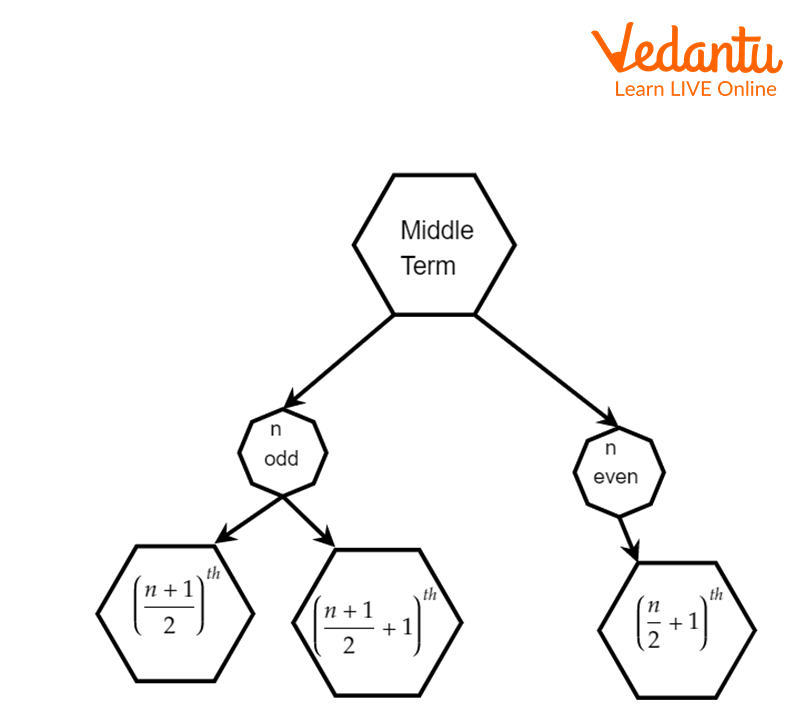




Introduction to Middle -Term Formula for a Binomial Expansion:
The middle-term formula is a formula used to find the middle term of a binomial expansion. Recall that a binomial expansion is an expression involving the sum or difference of two terms raised to some integral power. Depending on the total number of terms, we can write the middle term of that expression.
Definition of Binomial Expansion
A binomial expansion is an expansion of the sum or difference of two terms raised to some power n, where n is a positive integer. The general form of binomial expansion is
Some examples of Binomial Expansion are:
Binomial Theorem for a Positive Integer n
The Binomial Theorem gives the expansion of a binomial to any positive integral power. It is stated as:
There are (n+1) terms in a binomial expansion.
The compact form of binomial theorem is:
The index of the first term, i.e., ‘a’ decreases whereas the index of the second term, i.e., ‘b’ increases as we go from left to right in binomial expansion.
The coefficients of the terms
For Example, the binomial expansion of
General Term of Binomial Expansion
The general rth term of a Binomial Expansion
For Example, Given Binomial Expansion
Middle Term of Binomial Expansion
The Middle Term of a Binomial Expansion is the term that comes in the middle of the expansion of the binomial, given by the Binomial Theorem. If the power of expansion of the sum or difference of two terms is an even number, then there is only one middle term. Otherwise, there are two middle terms.
How To Find Middle Term?
The middle term of a Binomial Expansion depends on the total number of terms in the given expansion. If n is even, (n+1) is odd so that the expansion will have an odd number of terms. In this case, the middle term is

Middle Terms of a Binomial Expansion
Middle Term Example
Let us understand this by an example. Given a Binomial Expansion
For Binomial Expansion
and
Interesting Facts
The Binomial Theorem is used in Probability and Statistics. Our economy depends on it.
It is used for finding higher power roots of equations.
It is used to predict the weather and for giving rank to candidates.
Solved Examples
1. Find the middle terms in the expansion of (3-x3)7.
Ans: Given Binomial Expansion is (3-x3)7.
Here, n=7. So, n+1=8, which is even. The middle terms are
and
The middle term are
2. Show that the Middle Term in the expansion of (1+x)2m is
Ans: Given Binomial Expansion is (1+x)2m.
Step 1:
Finding the number of terms of the middle term:
Here, n=2m. So, n+1=2m+1, which is odd. So, the middle term is
The general term of
Step 2:
Compute
3. Find the value of α for which the coefficients of middle terms in the expansion of (1+αx)4 and (1-αx)6 are equal.
Ans: Consider the expression (1+αx)4. Here, n=4. So, n+1=4+1=5, and 5 is odd. The middle term is
Now, T3=T2+1
Now, consider the expression (1-αx)6. Here, n=6. So, n+1=6+1=7, and 7 is odd. The middle term is
T4=T3+1
Since the coefficients of both the middle terms are equal, so comparing both, we get
6α2 = -20α3
The value of α for which the coefficients of both the middle terms are equal is
Key Features
The position of the middle term of a binomial expansion depends on the total number of terms contained in the expansion(n+1).
If n is odd, the Binomial Expansion will have two middle terms:
If n is even, the Binomial Expansion will have one middle term:
Practice Questions
1. Find the middle terms in the expansion of
2. Prove that the coefficient of the middle term in the expansion of
FAQs on Middle Term Formula
1. What is a condition to apply binomial expansion negative power?
The condition to apply binomial expansion on
2. What is the name of the pattern that follows the coefficient of binomial expansion?
The coefficient in the binomial expansion follows a certain pattern that is known as Pascal’s triangle.
3. What is the number of terms of binomial expansion of
The number of terms of binomial expansion
























